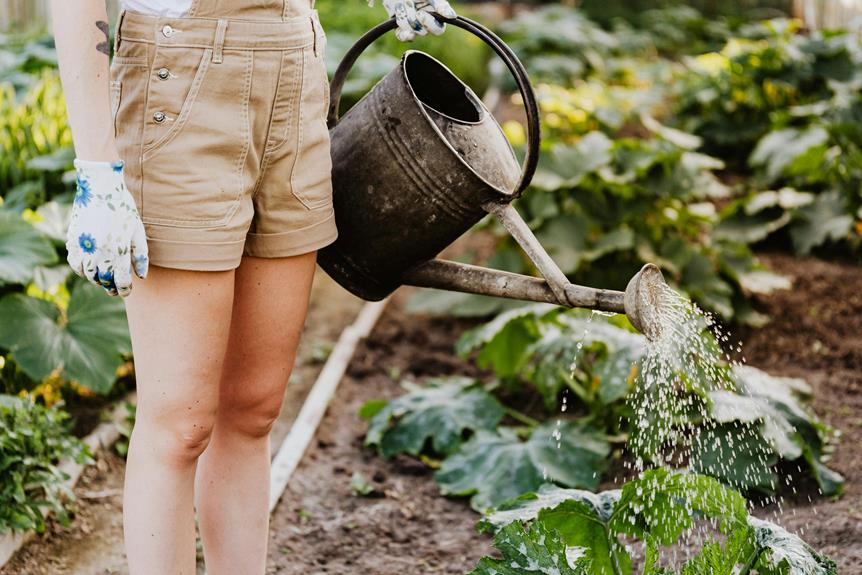
Keep your plants healthy during a heatwave by picking heat-tolerant varieties like cacti and succulents, watering deeply but less frequently either in the mornings or evenings, using shade cloth or natural shade to protect them, and staying vigilant for signs of distress. With these steps in place, your plants will be better equipped to handle the heat and thrive in challenging conditions.
Choosing the Right Plants
To keep your plants healthy during a heatwave, choose heat-tolerant varieties that can withstand high temperatures and intense sunlight. Opt for plants like succulents, cacti, marigolds, and sunflowers that thrive in hot conditions. These plants have adapted to survive in challenging environments and will fare better during extreme heat.
Succulents store water in their leaves, making them resilient to drought conditions. Cacti are also excellent choices as they require minimal watering and can handle intense sunlight. Marigolds not only add beauty to your garden but also have a high heat tolerance. Sunflowers, with their vibrant blooms, aren't only attractive but can endure the sweltering heat.
When selecting plants, consider their native habitats. Plants that naturally grow in arid regions or sunny climates are more likely to withstand heatwaves. Research different varieties and choose those that are known for their ability to thrive in hot weather. By carefully selecting heat-tolerant plants, you can ensure your garden remains vibrant and healthy even during the hottest days of summer.
Watering Strategies
Ensure your plants receive adequate watering to help them thrive during a heatwave. Water your plants deeply and less frequently to encourage deep root growth. Early mornings or late evenings are the best times to water, reducing evaporation and allowing plants to absorb water more effectively. Consider using a drip irrigation system or a soaker hose to deliver water directly to the roots, minimizing water loss through evaporation. Mulching around your plants can also help retain moisture in the soil, reducing the need for frequent watering.
Check the soil moisture regularly by sticking your finger into the soil; if it's dry an inch below the surface, it's time to water. Adjust your watering schedule based on the specific needs of each plant; some may require more water than others. During a heatwave, plants may wilt even if the soil is moist, so observe your plants closely to determine their water needs. Remember, overwatering can be as harmful as underwatering, so find the right balance to keep your plants healthy and thriving.
Shade and Shelter Solutions
During a heatwave, providing shade and shelter for your plants becomes vital to protect them from excessive sun exposure and heat stress. To shield your plants from the scorching sun, consider using shade cloth, umbrellas, or constructing temporary structures like lean-tos. These options help filter sunlight and reduce the intensity of heat reaching your plants. Placing potted plants under trees, awnings, or any existing structures can also offer natural shade. Additionally, positioning taller plants to create shade for more delicate ones can be an effective strategy.
Shelter solutions involve creating a microclimate around your plants to mitigate the effects of extreme heat. Grouping pots closely together can provide shade and reduce water evaporation from the soil. Mulching around plants helps retain soil moisture, regulates temperature, and prevents rapid drying. Moreover, using reflective materials on the ground can bounce sunlight back onto the plants, reducing heat absorption. By implementing these shade and shelter solutions, you can help your plants thrive even in the hottest conditions.
Monitoring and Adjusting
For optimal plant health in a heatwave, constant monitoring and adjustment are crucial. Keep a close eye on your plants during hot weather to ensure they aren't suffering from heat stress. Monitor the soil moisture levels regularly and adjust your watering schedule accordingly. Plants may need more water during a heatwave, so be prepared to increase the frequency of watering. Consider watering early in the morning or late in the evening to prevent water loss through evaporation during the hottest part of the day.
In addition to watering, pay attention to signs of wilting or leaf discoloration, which can indicate that your plants are struggling in the heat. If you notice any issues, make adjustments promptly. Providing temporary shade or shelter for sensitive plants can help them cope with extreme heat. Consider using shade cloth, umbrellas, or moving potted plants to a shadier spot.




